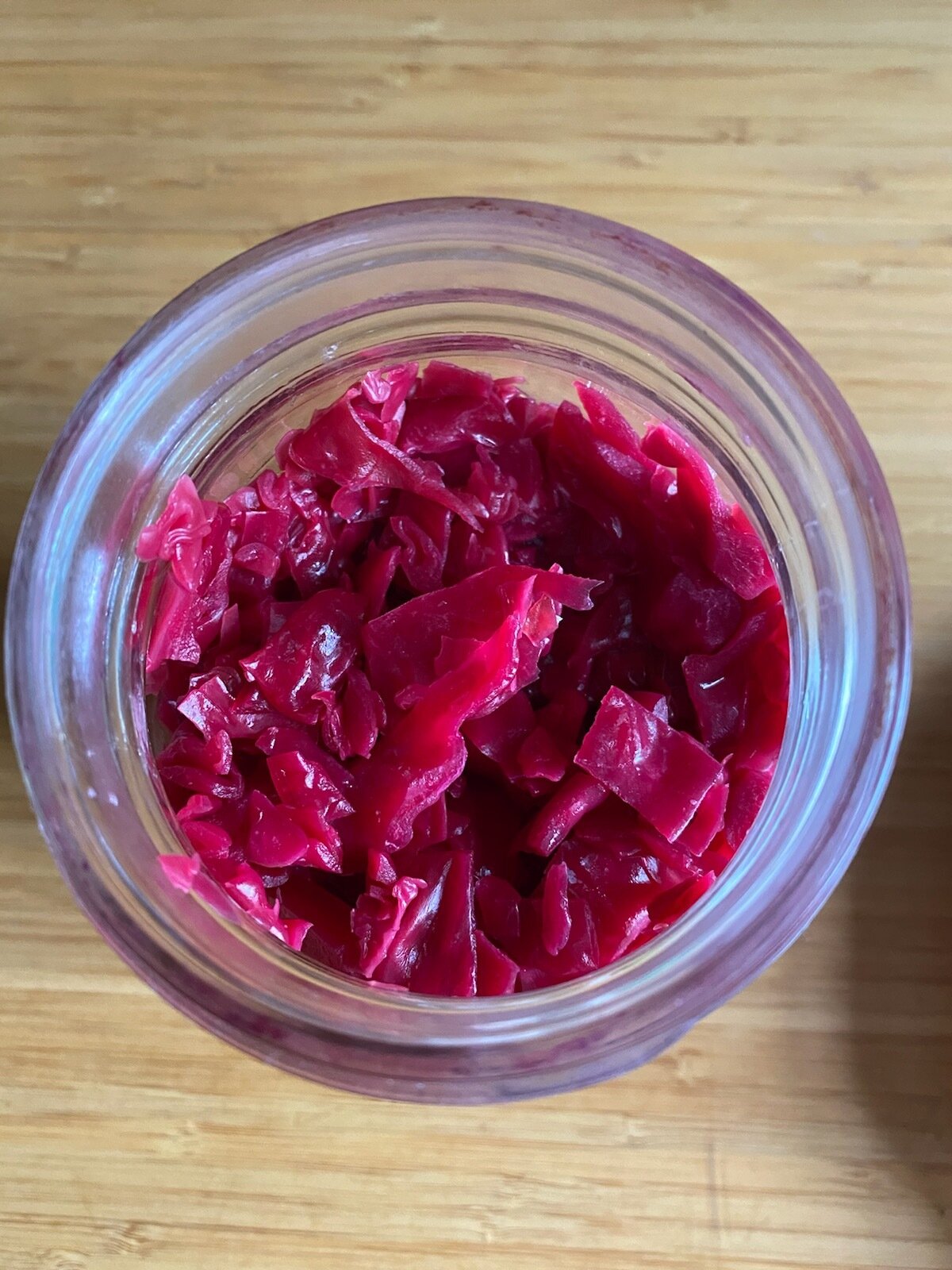Sour Herb
I hope you enjoyed last week's newsletter. I appreciate all of you for sharing your moments of joy with me. It made for a very Happy Birthweek.
Today, another one of my quick kitchen projects: Sauerkraut! Nothing fancy but impressive to those who’ve never tried, it’s like the typical DIYer’s first fermentation project. It’s meditative, easy and a great condiment or side dish.
About 3 years ago I was experiencing daily digestive problems and learned that probiotics is a way to nourish healthy gut flora. I was also eating a restricted paleo diet as part of an elimination process to learn which foods I may be sensitive to. Dairy wasn’t a part of my diet at the time so yogurt wasn’t an option. I’m ridiculously sensitive to alcohol so kombucha was definitely not an option either. I happened upon a recipe for small batch sauerkraut. Why make your own sauerkraut? Homemade sauerkraut is crisp, crunchy and sour. Rich in probiotics, vitamins and antioxidants. The stuff one can buy in the store is nothing compared to homemade. I don’t understand how they even have the same name. Store bought sauerkraut is also pasteurized so there’s no active bacteria/probiotics in it. Homemade sauerkraut goes well with brats or on a sandwich or as a wonderful salad addition. It goes well with anything really where you want to add crunch and sour. Sometimes I even throw a little in my bowls of soup instead of vinegar or lemon juice. (I literally just learned it’s a central ingredient in traditional Russian and Polish soups.)
This small batch recipe is perfect since it’s low commitment and low risk should it not turn out well (though that has yet to happen) and doesn’t take up much room. On the other hand it's very easy to scale up or down as needed. For those friends who like homemade goods it’s a sweet addition to a responsible out-of-doors socially distanced gathering or as a gift when you want to wish your loved ones good gut health.
I pulled the red cabbage I didn’t know what I was doing with out of my fridge (doesn’t everyone have cabbage randomly hanging out in their fridge?). Once you have everything you need for this little kitchen project it's about 20 minutes hands on time and then time to let the natural beauty of fermentation happen. Cabbage is pretty robust so any kind will do like green, savoy, napa or red cabbage.
What you’ll need:
Ingredients:
1 head of cabbage
Salt: ½ tablespoon per pound of cabbage
Dill or caraway (optional): 1 teaspoon per pound
Equipment:
Kitchen scale (not absolutely necessary but very handy)
Chef knife and cutting board
Large mixing bowl
Large jar like a wide mouth mason
Smaller jar (that fits into larger jar)
Stones or marbles or other weight (to go into small jar)
Cloth for covering the jar
Rubber band
Steps:
Do not clean. I repeat. Do Not Clean Your Cabbage. All the necessary bacteria for a good fermentation are on your cabbage. Wipe off dirt, if any, on your cabbage or just rinse that particular area.
Clean all your equipment with soap and water to ensure the good, beneficial bacteria have a good chance of fermenting the cabbage without interference. Please rinse everything well to be sure no soap residue remains.
Weigh the cabbage. Make note of this. It's helpful to know to determine how much salt to use. If you don’t have a kitchen scale use your best estimate. The only risk is using too much salt so err on the side of a little conservative.
Prep the cabbage. Remove the wilted, limp outer leaves of the cabbage. Set aside 1-2 leaves for covering the cut cabbage. Cut the head of cabbage in quarters then cut out the core. How to cut the rest of the cabbage is up to you. You can keep it simple by slicing the cabbage in one direction so you have short ribbons. I cut mine in a cross hatch so the pieces are square or rectangular. It’s the little things. Square pieces mean I can spoon my kraut out vs needing a fork.
Combine the ingredients. Transfer the chopped cabbage to the mixing bowl. Sprinkle the salt over the top.
Massage. Because everything in my life comes back to massage. Lightly break the fibers down while encouraging the spread of the salt to draw water out of the cabbage. It may not seem like enough salt initially but massaging: squeezing and pressing the leaves for 5-10 minutes will thoroughly spread the salt and begin the process of drawing water and sugars out to create the brining solution. The leaves should be limp and not as crispy as when you started. If adding seasoning, now is a good time to mix it in.
Pack it. Transfer the cabbage to the jar a handful at a time. Pack the cabbage down every so often with your hand if it fits in the jar or back of a long spoon. Pour all the liquid from the bowl into the jar. Tamp the cabbage down again. Place the large outer leaf into the jar. While giving the leaf some slack from the edges tuck the leaf in as tightly as possible to the cut cabbage.
Weigh it down and plate. Place the weighted smaller jar on the top leaf. This will help keep the cabbage submerged in its own brine. Place jar on a small plate.
Cover. I use 4 layers of cheesecloth but a napkin works well too. Take the cloth and lay over the small jar to completely cover the opening of the big jar. Secure with a rubber band. The cloth allows air flow but keeps dust and bugs out.
Press. Check on the jar several times over the next 24 hours. I find my jar typically overflows by the second day hence I always place the jar on a plate. If the cabbage is not fully submerged then every so often press on the smaller jar and tighten the slack of the cloth to hold it in place. Over time the cabbage will release more liquid, become more compact and the cabbage will finally submerge. If after 24 hours the tightly packed cabbage is still not submerged then dissolve 1 tsp of salt in 1 cup of water and add enough solution to submerge the cut cabbage.
Ferment. Check the sauerkraut daily. Continue to press the small jar down if the cabbage isn’t submerged. While the cabbage is fermenting make sure to keep the jar away from direct sunlight at a relatively comfortable room temperature. Because this is a small batch, fermentation should happen in a relatively short amount of time. This process can go anywhere from 3-10 days or longer. Start tasting daily after 3 days. When it tastes good to you then take out the small jar, clean the rim of any scum or bubbles, cap the kraut and put it in the fridge. Alternately, keep it where it is, scoop out a little everyday and taste how the flavor develops day to day. Make sure whatever you leave in the jar stays submerged in the brine. Foam on top is a good sign of fermentation. Mold on the other hand is not. Fear not. Scoop out any affected areas and keep fermenting the rest.
Store. Fully cured sauerkraut keeps for several months in an airtight container stored at 15 °C/60 °F or below. Though sauerkraut is technically shelf stable, I refrigerate mine eventually because it greatly slows the fermentation process. As long as it smells and tastes good to eat, it will be.
Choose cabbage that’s heavy with tightly packed leaves. This indicates higher moisture content. The amount of brining liquid in the jar will fluctuate. Initially the amount of liquid available will depend on freshness or how well the cabbage was stored before purchase. Then time: over time the cabbage will release more water thanks to massaging it with salt. The level of brine will also fluctuate in response to temperature. The warmer it is the more liquid and the faster the fermentation. Note, it is possible for it to be too warm. The risk is the cabbage will become mushy or begin to rot. The colder it is the less liquid there is. I don’t know why this happens but for as much liquid as there is in the jar before I refrigerate it all magically disappears after I refrigerate it. The primary concern while it’s fermenting is keeping the cabbage submerged in the brine so it's not exposed to air and undesirable bacteria.
What I’d like to experiment with but haven’t yet is adding other vegetables in with the cabbage to naturally pickle. I’ve read that carrot, apples and/or cranberries are typical additions. When you try making this goodness I’d love to know how it turns out. Enjoy!
Next week I’ll be examining the correlation between strength training and flexibility versus static stretching for mobility.
Until next we meet.


